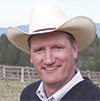Research recently conducted at Iowa State University showed that wild cattle gained about half a pound per day less than calm cattle and returned $61 less profit as well.
Research conducted by Dr. Rhonda Vann at Mississippi State University, in collaboration with Texas A&M University, showed that disposition has a direct effect on weight gain or loss and ultimate carcass quality.
Dr. Vann’s research showed that docile cattle were more feed efficient and more profitable even while grazing pasture.
According to her study, the wild cattle gained less in both the pasture and feedlot, had poorer ultrasound carcass data, had tougher meat, had a higher incidence of dark cutters and had more carcass discounts for lower quality than the docile cattle.This resulted in $60 less profit per head for the wild cattle compared to the docile cattle.
Both studies proved that docile cattle gained better, were safer to handle and produced more prime and choice grade carcasses. So what can producers do to improve disposition? Start by culling the really wild cattle in the herd and select replacement bulls and heifers with acceptable docility EPDs.
Understanding docility EPDs
Docility Expected Progeny Differences (EPDs) are one of the newer EPD values developed by the beef industry. It was first implemented by the North American Limousin Foundation and is now being used by the American Angus Association along with other breeds.
The docility EPD predicts the differences in probability that offspring will be scored either a 1 (docile) or 2 (restless) instead of a 3, 4, 5 or 6 (nervous to very aggressive) on the docility scale. The EPD for docility is expressed as a percentage. The higher the EPD value for docility means that the offspring should possess genetics for calmer behavior.
Docility scoring
EPDs for docility can be developed when purebred producers submit information on the temperament of their cattle. Below are the docility scores assigned to the cattle while they are held in a squeeze chute:
Docility Score
- Mild disposition, does not pull on headgate, exits chute calmly.
- Quiet, but stubborn, may pull back on headgate and exits chute quickly.
- Nervous and impatient but manageable. Repeated pushing and pulling on headgate, exits quickly.
- Flighty, wild, jumpy or out of control. Defecates and urinates during chute work, continually flicks tail. Has large flight zone and runs fence and jumps when pushed.
- Same attributes as score of 4 but is also aggressive. May exhibit attack behavior when worked singly. Very vocal in chute.
- Extremely aggressive. Thrashes about or attacks when pressed. Pronounced attack behavior.
How to use docility EPDs
Let’s say our cattle chase us around the pen and we want to select a bull that will improve our herd’s disposition. On sale day we look through the bulls and have narrowed our choice down to two prospects, Bull A and Bull B.
Bull A has a docility EPD of +15 percent and Bull B has a docility EPD of +5 percent.
Bull A = +15 percent
Bull B = +5 percent
_______
Difference 10 percent
In this example, 10 percent more of the offspring from Bull A will be expected to be scored either a 1 or 2 on the docility scale compared to the offspring of Bull B. Therefore we would want to select Bull A.
If we are looking at just one bull, we would need to compare the EPD to the breed average to determine if we were improving disposition. The Angus breed has an average Docility EPD of +9 percent.
If the bull we were about to buy had a +3 percent docility EPD, we would expect 6 percent fewer calves scoring a 1 or 2 for disposition compared to the average bull of the Angus breed. In other words, this bull would not improve disposition.
The average Docility EPD value for the Limousin breed is +15 percent. Keep this in mind if you are selecting a Limousin bull.
Summary
Production costs continue to increase for cattle producers. If we are losing $60 per head due to disposition, it is time to make genetic selections to reduce the number of bad actors and in turn increase profits. As mentioned earlier, wild cattle:• Are a safety risk to handlers and other cattle
- Increase the requirements for handling equipment
- Are a liability exposure for producers
- Cause reduced feed efficiency and feedlot performance
- Create carcass quality issues
- Cost money
Evaluate your herd in the fall at weaning time. Use the disposition scores outlined above to evaluate your replacement heifers. You may want to actually assign each heifer a score. Develop a selection criteria (i.e. anything with a score of 4 or above is culled) and put it into practice.
If you determine you have a disposition problem, consider using docility EPDs when you go to buy your next bulls. There are several breeds that have developed docility EPDs.
Producing good disposition cattle will pay in the long run. Your hired help and your spouse will thank you as well. ![]()








